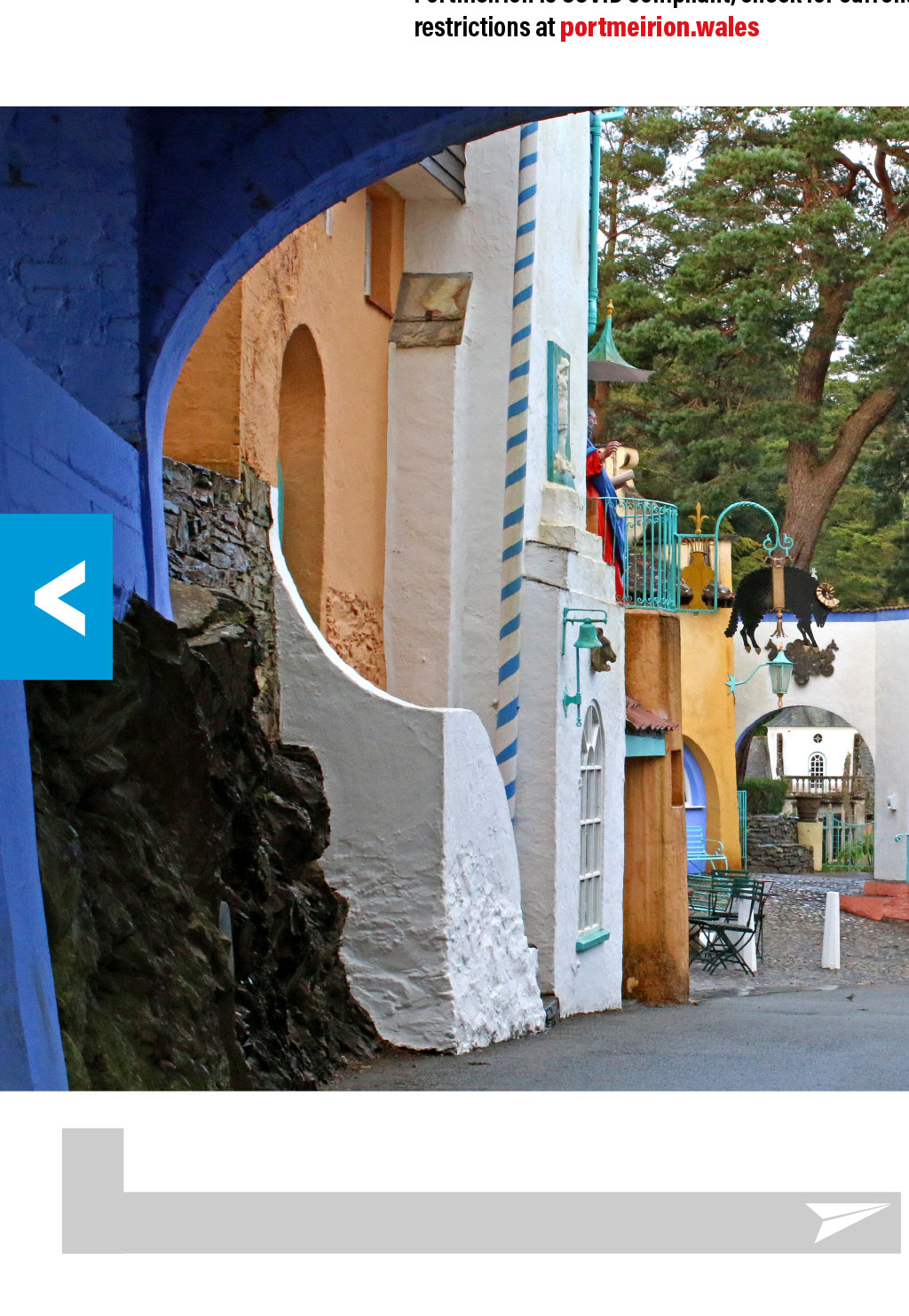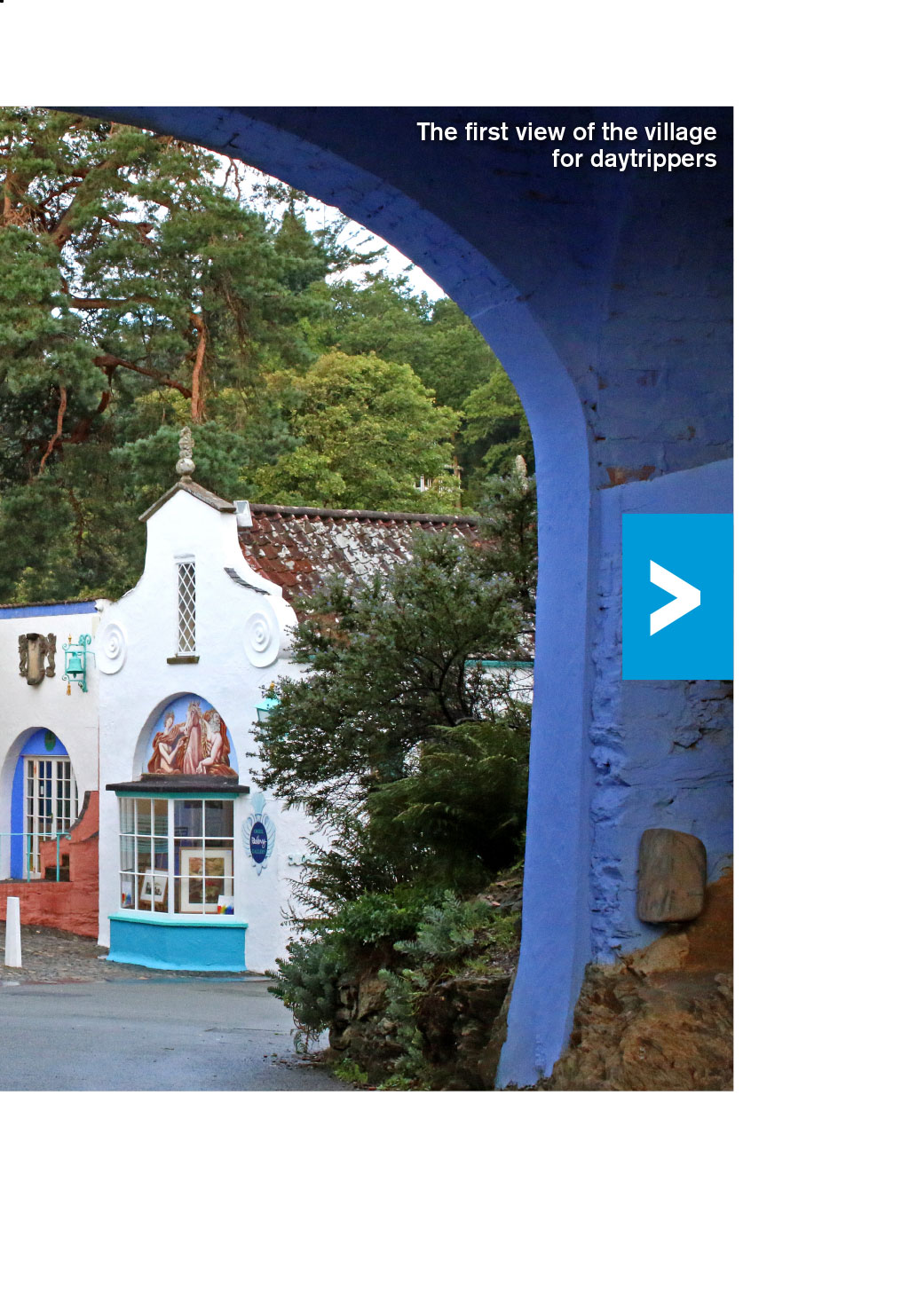




























TRAVEL Willing prisoners A lockdown-inspired breakout closer to home By Captain Robin Evans, Senior Log Contributor wake and walk to the window, framing a colourful, landscaped village grafted onto a hillside. Overlooking the sea, a bell tower rings and palm trees wave gently: an evocative view worth exploring. This morning its as deserted as Id hoped; a wry, historic pilgrimage Ill return to later. I pass under an archway into a square, overlooked by an Italianate tower and an ornate, weathered dome. A sensory assault, painted in pastel tones with exotic follies: a huge Buddha sits beneath an awning. The view opens over a deserted piazza, where I pass beneath my own window. I walk faster, footsteps echoing on the deserted cobblestones. Further down, a stone boat is anchored into the sea wall. It sails the eye out over a vast, sandy plain, the tide having escaped far beyond sight. A coastal path tempts me along, jungly woodland a riot of colour in the local microclimate. Unique vision Perspective. With travel opportunities rare, were appreciating places closer to home places that always existed, waiting patiently. The idea of domestic destinations impersonating foreign ones isnt new, the travel world dubbing it the fake-ation. Forget any temporary illusion, however; digging deeper often reveals treasure in its own right. My current spot represents maximum Mediterranean flavour for minimum travel in summer, temperature included. The secret? Bypass Italy or Greece and head for North Wales, where youre never far from a legend. Outside Porthmadog (just Port to the locals) is an intersection of two. In 1925, Welsh architect Clough Williams-Ellis inherited a neglected spot, hemmed between tide and terrain on the edge of Snowdonia. He began repurposing parts of other structures into his sanctuary for fallen buildings long before any mainstream notion of architectural salvage. In a nod to its coastal location and the old Welsh county in which it stood, he called his lifes work Portmeirion. One mans vision, and it took him 50 years to do it. The word unique is used too much nowadays, but this is very, very special, explains affable location manager Meurig Jones. Clough had this burning ambition what he called propaganda for architecture; that it had a message and proved you could work with nature, but have fun doing it. Join one of Meurigs jovial tours and hell point out the architectural trickery: forced perspective making buildings smaller to appear further away. Meurig explains how Portmeirion has always beguiled creative types, the work of one in particular especially resonant. Prisoners Its 1966: Beatlemania and World Cup glory, plus the darker spheres of the Space Race and Cold War. Megawatt actor Patrick McGoohan has an ambitious antidote to the tired spy hero format. His masterwork is the claustrophobic, cult TV series The Prisoner, which begins shooting at Portmeirion. The opening titles make a cruel introduction. McGoohan plays an anonymous agent whose resignation goes badly. He wakes from a drugged stupor at home and rises to the window, the curtains instead revealing a view like my own this morning. Each episode escalates a new psychological manipulation designed to make a citizen of the defiant inmate, known only as Number Six. One riffs on the idea of waking up in a ghost town, something I recreate with my morning walk. Meurig is one of few people to experience this for real, agreeing that the last year has all the hallmarks of an episode of The Prisoner. Ill never forget standing there at midday on the first day in lockdown. All I could hear was the sound of birds and nothing else. Its just unheard of. In 94 years, we were never forced to close. Even through wartime we were busy. Wonderment In a cast of rotating antagonists, there were two constants in The Prisoner. Fiery McGoohan lived out an increasingly tortured vision on screen, contrasting with his otherworldly location. The effect was a sinister veil pulled over an idyllic place. The visions of architect and actor had aligned: 17 uncompromising episodes released on an unsuspecting public in 1967. Portmeirions warm tones soothed the brave new world of colour broadcasting. After seeing the first rushes, Clough thanked McGoohan for enhancing his creation. When seen in colour at the local cinema, a performance he kindly arranged, Portmeirion itself seemed, to me at least, to steal the show from its human cast. The content, meanwhile, seethed, as challenging for its driven leading man as its audience. For clever fiction, it was based on truth: a Scottish wartime facility where Her Majesty detained personnel for their own An idyllic setting with only the Welsh flag giving away its location READ MORE FULL CIRCLE More ideas along the Snowdonia360, a 360-mile North Wales itinerary Llama trekking, Black Rock Llamas Morfa Bychan Menai Straits RibRide powerboat Zip World, Penrhyn and Bounce Below Blaneau Ffestiniog Electric Mountain Dinorwig Zip World Fforest Betws-y-Coed A village view similar to the one that began each episode of The Prisoner I pass under an archway into a square, overlooked by an Italianate tower and an ornate, weathered dome. A sensory assault, painted in pastel tones with exotic follies protection. Strangely prophetic, its messages about surveillance, political manipulation and personal freedoms have become startlingly relevant over the intervening decades the last year especially. Meurig cites its intelligence. There arent many series that can sustain such interest after 54 years. Its well written, well produced, and the village is a character within it. The fans are still debating what it all means. Hes speaking for the series, but his sentiment applies equally to the setting, their longevity a product of integrity. Clough abhorred the idea of a sterile museum piece, his lifes work needing public interaction to live and breathe. It needs people in it you can see the wonderment on their faces, Meurig says. One of the most visited Welsh tourist attractions, 220,000 annual day visitors agree. Character READ MORE Full Circle The most authentic experience comes as a willing prisoner after hours, while staying in its individual character cottages. Imagine boutique hotel rooms with a woodland-cocooned, Alice in Wonderland film set at the window. I meet a family whove made this their annual pilgrimage for three generations. Meurig later explains this is typical: people visit for the day, then, suitably bewitched, they return to stay, gradually working their way around the village. Children love it. English serves as an embedded, secondary tongue here in Gwynedd, the regional accent a sing-song lilt. One of the staff crouches down and whispers conspiratorially to my young daughter: There are things here youre not meant to find until your third or even fourth visit, but Ill tell you one Placing The Prisoners preserved locations brings a deceptive village to life. We are really a film set in that respect, and we havent changed. We are a capsule to that time, says Meurig. In person, the village reveals some of The Prisoners secrets: Number Sixs residence, now a themed souvenir shop, is tiny, concealed by clever editing. If you want to maximise the immersion, The Prisoner runs permanently on an in-house TV channel. The only things needed to complete the effect are a mute butler and being chased by a screaming white orb. Entirely coincidental today are two moments mirroring the opening scenes of the first episode, Arrival. First, despite the early hour, I have a feeling Im not alone: I spy a distant figure in a pagoda, but on second glance its empty, as if Id imagined it. Second, Im later reminded of scene dialogue about cosmopolitan inmates speaking European languages. Today, diverse accents can all be overheard chattering excitedly. If this was rare for 1960s North Wales, five decades on, fiction has become fact. Snowdonia is now much better known as a tourist area theres much more to do here, says Meurig. Legacies Appropriately titled Fallout, McGoohans finale triggered opposing responses from an enthralled public. Callers jammed the broadcasters switchboard, demanding answers; the only one given was the filming location, disclosed in the final credits. Before The Prisoner, we had 50,000 day visitors a year, which instantly doubled after the final episode, reveals Meurig. He notes how the more subversive episodes were originally banned, since reinstated for new generations. The Prisoner is now accessible on streaming channels in the UK. Awarded the CBE for his work, Clough Williams-Ellis died in 1978, aged 94. Forever colourful, his ashes were launched aloft by firework. McGoohan left us in 2009, having long since escaped the UK, the burden of public confusion imprisoning even him. He rarely commented on The Prisoner, but delighted in the debate it provoked. These two visionaries shared a desire to do something unique. That both legacies can be enjoyed together is rare. You cant help but be happy and inspired by it, says Meurig. I sense hes speaking equally for visitors and his colleagues keeping the place ready for reopening, for whom it is far from a prison. A weekend in North Wales never sounded so arresting. Portmeirion is COVID compliant, check for current restrictions at portmeirion.wales Spring, and with it the daffodils, arrives in Portmeirion The first view of the village for daytrippers High tide in Portmeirion Portmeirion creator Clough Williams-Ellis (left) meets The Prisoner, Patrick McGoohan